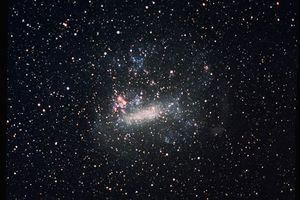التصنيف الشكلي للمجرات
التصنيف الشكلي للمجرات Galaxy morphological classification هو نظام يستخدمه الفلكيون لتقسيم المجرات إلى مجموعات على أساس مظهرها المرئي. وهناك العديد من المناهج المستخدمة التي يمكن بها تصنيف المجرات حسب أشكالها، وأشهر تلك المناهج تسلسل هبل، الذي أنشأه إدوين هبل ولاحقاً وسعه جيرار ده ڤوكولير و ألان سانددج.
. . . . . . . . . . . . . . . . . . . . . . . . . . . . . . . . . . . . . . . . . . . . . . . . . . . . . . . . . . . . . . . . . . . . . . . . . . . . . . . . . . . . . . . . . . . . . . . . . . . . . . . . . . . . . . . . . . . . . . . . . . . . . . . . . . . . . . . . . . . . . . . . . . . . . . . . . . . . . . . . . . . . . . . .
تسلسل هبل
| Galaxy Type | Mass (Solar Masses) | Luminosity (Solar Luminosity) | Diameter (kpc) | Stellar Populations | Percentage of Observed Galaxies |
|---|---|---|---|---|---|
| Spiral / Barred Spiral |
109 to 1011 | 108 to 1010 | 5-250 | disk: Population I halo:Population II |
77%[بحاجة لمصدر] |
| Elliptical | 105 to 1013 | 105 to 1011 | 1-205 | Population II | 20% |
| Irregular | 108 to 1010 | 107 to 109 | 1-10 | Population I | 3% |
| Name | Right Ascension | Declination | Hubble Type |
|---|---|---|---|
| M49 (NGC 4472) | 12h 29.8m | 8° 00' | E4 |
| M59 (NGC 4621) | 12h 42.0m | 11° 39' | E3 |
| M60 (NGC 4649) | 12h 43.7m | 11° 33' | E1 |
| M84 (NGC 4374) | 12h 25.1m | 12° 53' | E1 |
| M86 (NGC 4406) | 12h 26.2m | 12° 57' | E3 |
| M89 (NGC 4552) | 12h 35.7m | 12° 33' | E0 |
| M110 (NGC 205) | 00h 40.4m | 41° 41' | E6 |
وأيضا أمكن حديثا تصنيف المجرات إلى ثلاثة أنواع بالنسبة لشكلها:
- المجرات الاهليليجية (البيضاوية) irrigular
- المجرات اللولبية (الحلزونية) Spiral
- المجرات غير المنتظمة Elliptical
وتدل الإحصاءات الفلكية أن حوالي ٧٨ % من المجرات لولبية و ١٨ % اهليليجية ٤% فقط غير منتظمة. وهذه البلايين من المجرات تنطلق بسرعة هائلة في الفضاء ويتخذ كل منها اتجاها يبتعد بها عن المجرات الأخرى و لنلق نظرة فاحصة على محتويات كل نوع من المجرات لنتعرف على هذه الجزر الكونية الجبارة.
De Vaucouleurs system



Numerical Hubble stage
| Hubble stage | -6 | -5 | -4 | -3 | -2 | -1 | 0 | 1 | 2 | 3 | 4 | 5 | 6 | 7 | 8 | 9 | 10 | 11 |
|---|---|---|---|---|---|---|---|---|---|---|---|---|---|---|---|---|---|---|
| de Vaucouleurs class[1] | cE | E | E+ | S0- | S00 | S0+ | S0/a | Sa | Sab | Sb | Sbc | Sc | Scd | Sd | Sdm | Sm | Im | |
| approximate Hubble class[2] | E | S0 | S0/a | Sa | Sa-b | Sb | Sb-c | Sc | Sc-Irr | Irr I | ||||||||
The use of numerical stages allows for more quantitative studies of galaxy morphology.
Yerkes (or Morgan) scheme
Created by American astronomer William Wilson Morgan. Together with Philip Keenan, Morgan developed the MK system for the classification of stars through their spectra. The Yerkes scheme uses the spectra of stars in the galaxy; the shape, real and apparent; and the degree of the central concentration to classify galaxies.
| Spectral Type | Explanation |
|---|---|
| a | Prominent A stars |
| af | Prominent A-F stars |
| f | Prominent F stars |
| fg | Prominent F-G stars |
| g | Prominent G stars |
| gk | Prominent G-K stars |
| k | Prominent K stars |
| Galactic Shape | Explanation |
|---|---|
| B | Barred spiral |
| D | Rotational symmetry without pronounced spiral or elliptical structure |
| E | Elliptical |
| Ep | Elliptical with dust absorption |
| I | Irregular |
| L | Low surface brightness |
| N | small bright nucleus |
| S | Spiral |
| Inclination | Explanation |
|---|---|
| 1 | Galaxy is "Face-on" |
| 2 | |
| 3 | |
| 4 | |
| 5 | |
| 6 | |
| 7 | Galaxy is "Edge-on" |
So, for example, the Andromeda Galaxy is classified as kS5.
انظر أيضاً
- Morphological Catalogue of Galaxies
- Galaxy color-magnitude diagram
- Galaxy Zoo
- William Wilson Morgan
- Fritz Zwicky
References
هذه المقالة بحاجة لمصادر إضافية لتحسين وثوقيتها. (October 2007) |
وصلات خارجية
- Galaxies and the Universe - an introduction to galaxy classification
- Near-Infrared Galaxy Morphology Atlas, T.H. Jarrett
- The Spitzer Infrared Nearby Galaxies Survey (SINGS) Hubble Tuning-Fork, SINGS Spitzer Space Telescope Legacy Science Project
- Go to GalaxyZoo.org to try your hand at classifying galaxies as part of an Oxford University open community project
- CS1 errors: unsupported parameter
- Articles with hatnote templates targeting a nonexistent page
- Articles with unsourced statements from September 2007
- Articles needing additional references from October 2007
- All articles needing additional references
- Galaxies
- أنظمة التصنيف
- فلك خارج المجرة
- الأنواع الشكلية للمجرات


